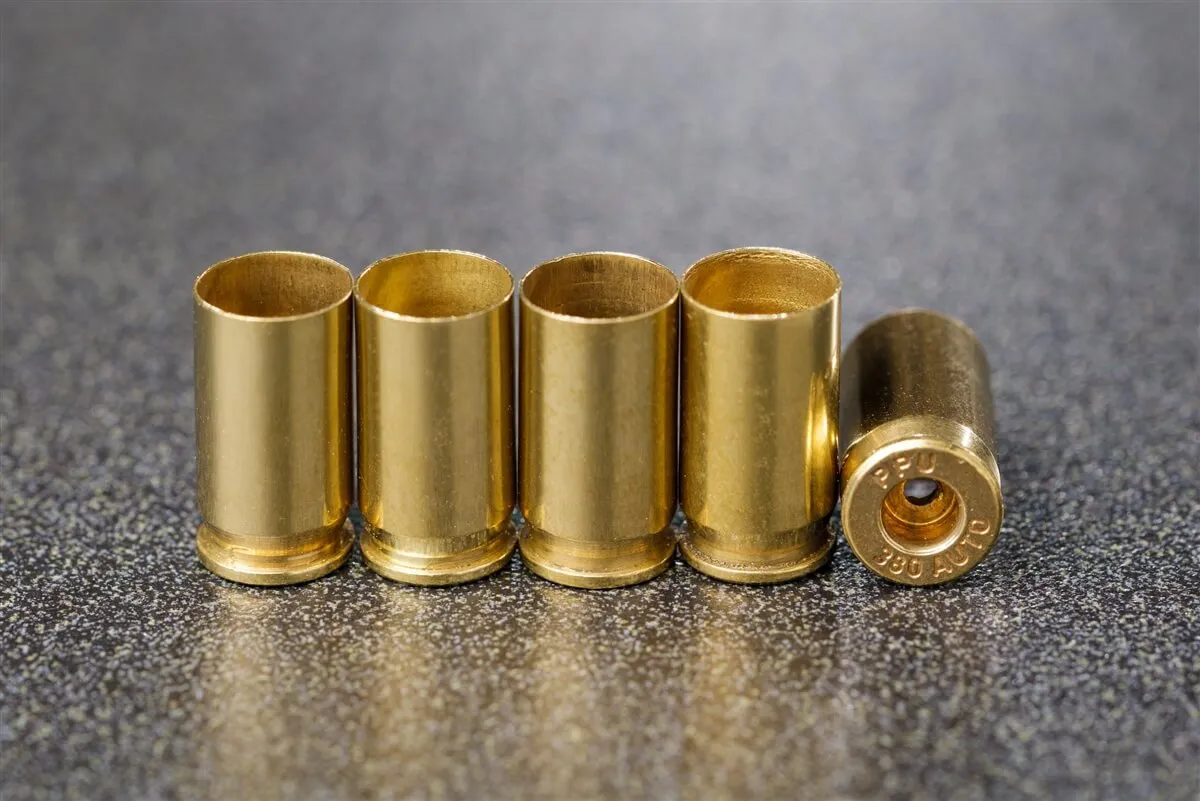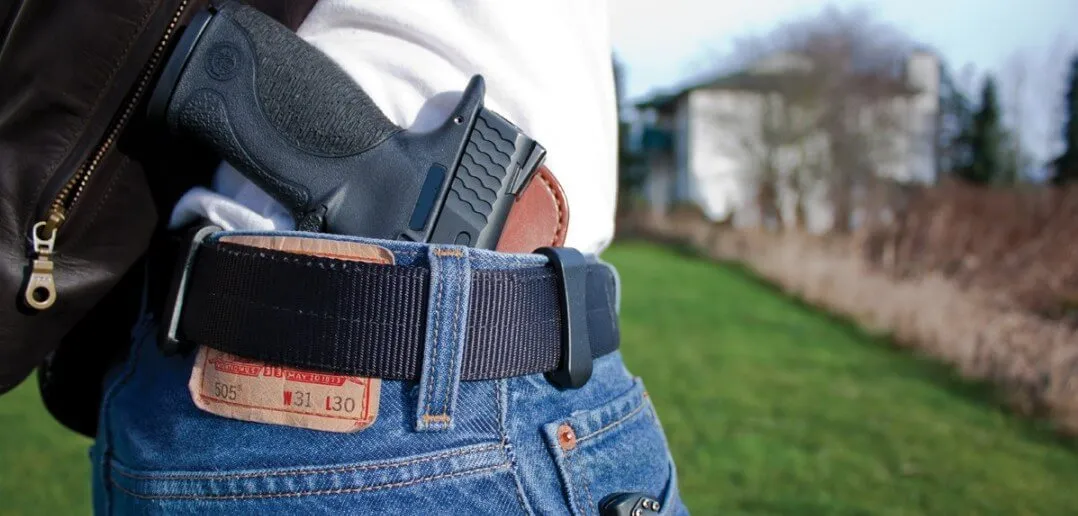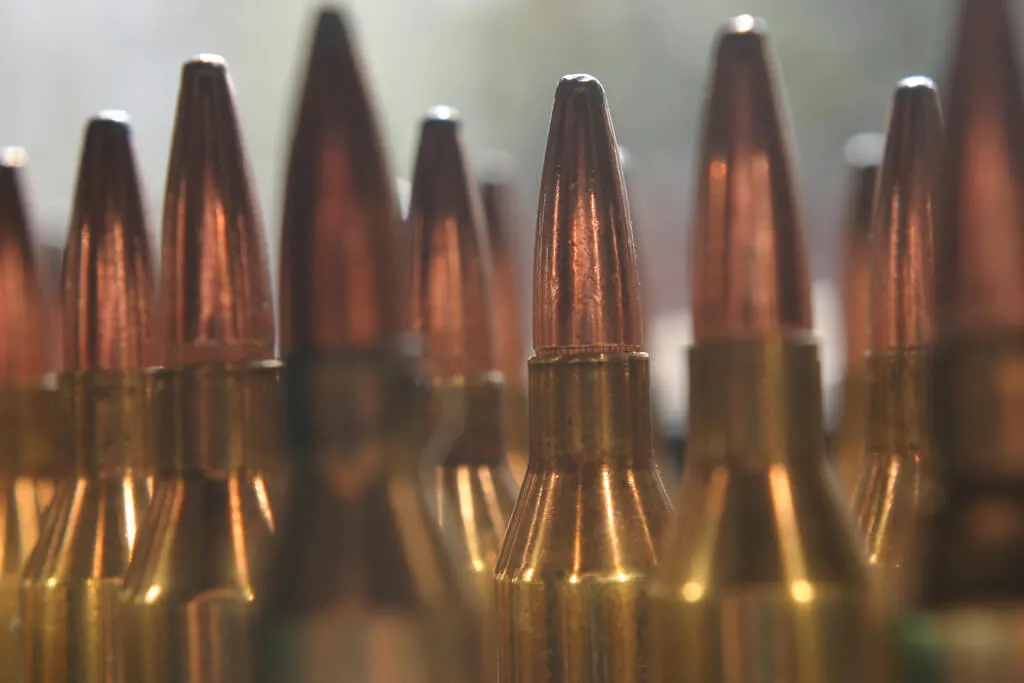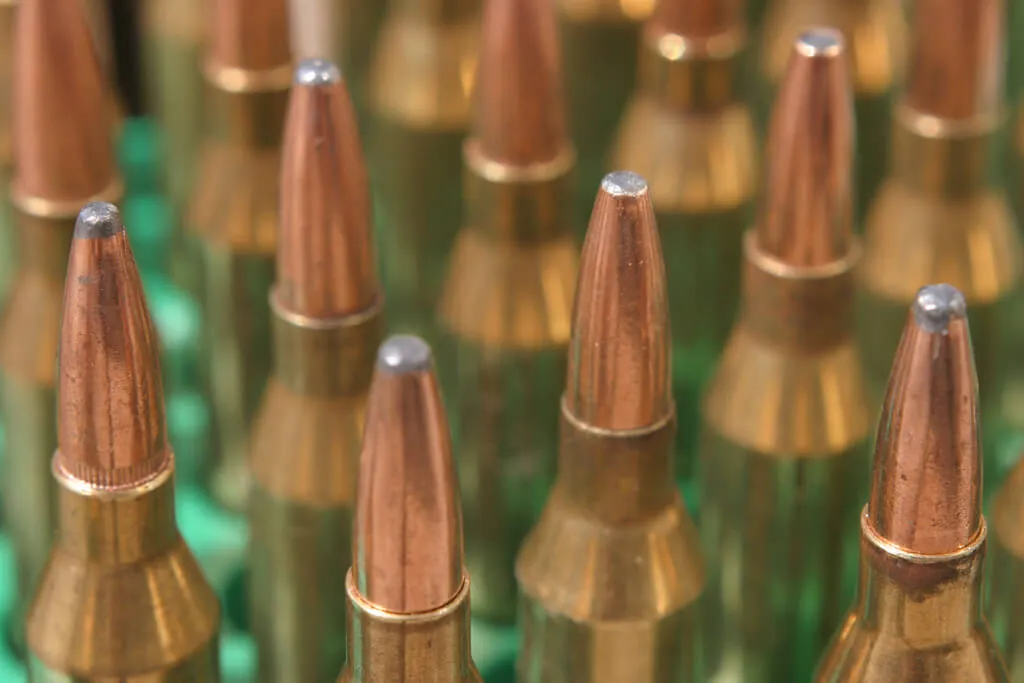Bullets, primers, powder, cases, cartridges, .38 special, 9mm, 5.56 NATO, oh my! More bullet types than you can shake a stick at.
If you're new to firearms, it can feel really intimidating and confusing when everyone at the gun store (except you) is rattling off numbers and names of calibers and bullets.
Fear not, while this is a weird and strange world we live in and the names given to bullets and cartridges are often misleading -- we'll break down the basics and help to demystify all of it!
BONUS OFFER: Get your free shooting range targets to print at home!
Get your free targets to print at home!
What is A Bullet?
The word "bullet" came from the Middle French word "boulle," which means "small ball." It is the kinetic projectile of the ammunition shot from a gun barrel.
In short, it's the only part of the cartridge that leaves the gun barrel.

While it is common for people to call the entire cartridge the "bullet", this is really just slang.
Truthfully, the bullet is only one part of the cartridge as a whole.
![Bullet Types [The Ultimate Guide] Cartridge Parts Bullet is only a part of the cartridge](http://143.244.165.192/wp-content/uploads/2021/07/image16-1.jpg)
Always remember that the bullet is only a component of the cartridge. It's not the ammunition itself.
Bullets are usually made from copper and lead. However, depending on the use, they might be made of steel, polymer, rubber, and even wax.
Bullets also come in different shapes and sizes, depending on their purposes. There are bullets made for hunting, target shooting, training, and more.
Did you know that the first bullets are cast-lead balls? The bullet also underwent a lot of development before coming up with its modern design today. To further understand this, let's have a quick history.
History of the Bullet
Unsurprisingly, very early bullet types were basically small cannonballs. Fired from smoothbore metal tubes the earliest firearms were little more than handheld cannons.
Lead quickly became a favorite material to make bullets out of because it is plentiful, inexpensive, easy to form, and doesn't damage the barrel.
![Bullet Types [The Ultimate Guide] Round Stones and Metal Rounds](http://143.244.165.192/wp-content/uploads/2021/07/image23-1-1024x768.jpg)
Modern bullets share little in common with those mini-cannon balls, but it took well over 400 years of technological advancement to get bullet types where they are today.
For the vast majority of that time, bullets were as simple as simple gets.
The First Firearms
People first used fire lances made of bamboo filled with gunpowder. They attached the lances to spears that spew flame after lighting the fuse.
In the 14th century, during the Middle Ages in Europe, people shaped molten metal like iron into a round shape. Later, they began to use lead.
Lead balls were the first bullets shot from firearms. While making a gun often required an experienced craftsman, making bullets was something that often fell on the owner wherever they may be.
Lead is easy to work with and simple for an average person to learn to use to make bullets.
Development of the Modern Bullet
In the 1830s, French infantry captain Henri-Gustave Delvigne designed cylindro-conical bullets rather than spherical ones.
His design has a cylinder-shaped body with a pointed head. After some time, French artillery captain François Tamisier added grooves to improve the bullet's stability.
In the 1840s, French army officer Claude-Étienne Minié designed the Minié ball. It had a hollow base and three grooves to fit easily in rifles. Thus, it became the first modern bullet. This also proved to be a massive advancement in bullet type lethality.

In the 1880s, Swiss engineer Eduard Rubin encased a soft lead core within a copper alloy, creating the first full metal jacket bullet. Giving the lead a harder jacket allows the bullet to have better ballistics due to less deformation when shot.
Then, in the 1890s, Captain Georges Raymond Desaleux of France wanted to minimize the bullet's air resistance.
As a result, he designed an elongated bullet and added a thin cylinder on top of a thicker one. His design allowed accuracy for long distances than previous designs.
This design is the "Spitzer" bullet, which was enhanced further by adding a boat tail base.

Bullet types still use the basic Spitzer shape but have also developed further into different types until we have the design of our bullets today.
Types of Bullets

Bullet types come in more shapes, sizes, and materials than we can list here. But it's for good reason as they serve different purposes and have their own pros and cons.
These are some of the most common types of bullets, but there are more out there that serve niche cases.
Cast Bullets
These are bullets normally entirely made of lead. Cast bullets are heavy yet soft and they easily deform. Most manufacturers produce cast bullets made of lead and tin or antimony.
![Bullet Types [The Ultimate Guide] Cast Bullets](http://143.244.165.192/wp-content/uploads/2021/07/image25-1.jpg)
It can also be a mix of metals which can add hardness to the bullet. At times, some use zinc when there is a shortage of lead material or if there's a concern about lead toxicity.
Generally, these are cheap and easy to produce even at home with the right tools and a little know-how.
They are also the most basic form of a bullet and are rarely used for anything other than just shooting at the range.
For defensive use, hunting, or competitions -- it's better to use a bullet made for the purpose.
You can read our complete guide to casting bullets for more info on this.
Full Metal Jacket

A full metal jacket (FMJ) is a bullet with a jacket of hard metal covering the softer core.
The jacket may surround only the front and sides of the bullet or the entire core.
Usually, the jacket material is copper and covers the lead core to prevent deformation. Even their shapes vary and come in pointed, round, or flat.
The FMJ is the traditional choice for the firing range since it is cheap to mass-produce. Moreover, the added jacket allows higher muzzle velocities and preserve aerodynamics better than bare lead.
The wound channels from this type of bullet are small, and they often go through the target. Therefore, FMJs are ideal for training and not for self-defense.
Soft Point
Also called a "soft-nosed bullet," a soft point is encased in a partial jacket that leaves the exposed lead core at the tip.

Soft points are popular with hunters because the exposed lead expands when it hits a soft tissue. This acts much like a hollow point bullet as it will expand and deform in the target.
The tip of the bullet reacts by squashing inward and expanding wider than its original bullet diameter, causing a large wound hole. This type of bullet is ideal to use for hunting, but the expansion can be unpredictable and unreliable.
Popular Articles
Jacketed Hollow Point
A jacketed hollow point (JHP) is a bullet with a hollowed-out cavity in the tip. It's designed to expand upon impact.

The jacket initially offers better penetration before opening a wide wound cavity. The tip usually turns into a mushroom shape or flower bloom shape.

This type of bullet is ideal for hunting and self-defense. It's also more on the expensive end.
Open Tip Match
Open tip match (OTM) bullets may appear like hollow points because of their small opening on top, however... they are not.
OTMs have a tiny opening at the top because of their manufacturing process. However, these openings don't expand like hollow points as their openings are too small.

Sierra Bullets introduced the OTM bullets in the 1950s and they have been popular with target and long-range shooters ever since.
These are normally designed for reaching out and are commonly the preferred design when shooting 100-1,000+ yards.
Ballistic Tip & Boat Tail
Ballistic tip bullets are a bit tricky. Sometimes they are designed to give the ballistics of FMJ/OTM bullets but the expansion of hollow points, but sometimes they are just designed to give amazing long range ballistics.

A boat tail (BT) bullet has its bottom part more streamlined. This design helps hold weight well when shooting and helps stabilize the projectile while in the air.
Wadcutter
The shape of this bullet type is flat. Sometimes, it has a nearly flat front that is typically as wide as the caliber size. Wadcutters are a special-purpose bullet designed specifically for paper target shooting at close ranges.
![Bullet Types [The Ultimate Guide] Wadcutter](http://143.244.165.192/wp-content/uploads/2021/07/image33.jpg)
The shape helps reduce errors in scoring by making a very clean and crisp hole in the paper. You won't see wadcutter bullets in ranges very often as wadcutter bullets are more for use in handgun and air gun competitions.
Semi-wadcutter
Giving the same advantages on paper targets that a wadcutter gives, but also delivering a bit more ballistic smoothness for better muzzle velocity.
![Bullet Types [The Ultimate Guide] Semiwadcutter](http://143.244.165.192/wp-content/uploads/2021/07/image3-3.jpg)
Before the invention of modern hollow points, semi-wadcutters were also popular with self-defense ammo since they are normally made of pure lead and will deform in soft tissue.
However, since the rise of modern self-defense ammo, semi-wadcutters are rarely used for self-defense ammo.
BONUS OFFER: Get your free shooting range targets to print at home!
Get your free targets to print at home!
Parts of a Cartridge
Upon opening a box of ammunition, the first things you see are the cartridges. Most people call them bullets. However, the correct term for this is cartridge — it's the whole component of the ammunition.
The bullet is only a part of the cartridge. So, if that's the case, then what makes up a cartridge?
![Bullet Types [The Ultimate Guide] Parts of a Cartridge](http://143.244.165.192/wp-content/uploads/2021/07/image32-1.jpg)
Primer
The primer is the ignition for the propellant. You can find it as a round dimple found on the base of the cartridge.
With just a small amount of pressure-sensitive "priming compound", the primer is struck by the firearm's firing pin, crushed, and detonated. The spark it creates travels through the flash hole to the main propellant charge and ignites it.
Case
Usually made from brass, nickel, steel, or an alloy of metals. This is also the part of the cartridge that holds all components together.

Powder/Propellant
Powder or propellant is gunpowder. Once ignited, the burning powder creates gases that rapidly expands and pushes the bullet into and out of the barrel.
Bullet
The bullet is the kinetic projectile of the cartridge that leaves the barrel.
Types of Cartridges
![Bullet Types [The Ultimate Guide] Rimfire vs Centerfire](http://143.244.165.192/wp-content/uploads/2021/07/image27.png)
Rimfire
A type of cartridge where the priming compound is built into the rim, rimfire is an old school design. While once very common and came in many different shapes and sizes, rimfire is an older design that is not as reliable as centerfire.
One lasting and great example of a rimfire cartridge is the .22 LR.

Centerfire
By far the most common type of cartridge, centerfire means the primer is located in the center of the base of the case.

It's easy to know if it's centerfire. Look at the rear of the cartridge, and you'll see that it has a round center in the middle.
Shotshells
Shotshells are cartridges that contain the projectiles in shotguns. They are technically centerfire, but are different enough from normal centerfire cartridges that we'll give them a section all their own.

Common Calibers
You may be wondering what the number in caliber names means, I'll tell you but you won't like the answer.
It means almost nothing. Kind of.
Generally, the number denotes the size of the bullet used in the caliber -- but not always and not exactly.
Rounding the number to something that rolls off the tongue easier is very common, as is fugging the number a little just to differentiate it from another common cartridge.
Examples? .223 Remington is actually .224 inches in size.
.38 Special and .357 Magnum are both .357 inches.
7.62x51mm NATO is actually 7.8mm diameter. And 7.62x39 is really 7.92mm.
.22 Long Rifle
The .22 long rifle is one of the most common cartridges available. You can find it almost anywhere and it's a great starter round for beginners.

Its recoil is also almost nonexistent, and it's available at a low price.
Normally ranging between 30 and 40 grains, the .22 LR is a lightweight bullet that is commonly made of pure lead.
Although normally regulated to hunting small game or popping soda cans at the range, long range .22 LR shooting has grown very popular in the last 5 or so years. Shooting .22 LR at 100-400 yards is a real challenge!
.380 ACP
Also called the 9mm short, this caliber boosted popularity because of the "pocket pistols" introduced in the market.

Relatively lightweight and smaller than many other calibers, .380 ACP is often considered the smallest viable self-defense cartridge. Anything smaller and lethality drops off significantly.
9mm Luger / 9x19 Parabellum
The 9mm cartridge has many names but they all mean the same thing.
One of the most popular pistol cartridges worldwide, the 9mm is reliable for self-defense use and modern bullet design makes it highly lethal.

Popular with militaries and police forces around the world, 9mm Parabellum has been around since 1901 and has almost always enjoyed huge popularity.
If you're not sure what to get, 9mm is always a great choice.
.40 Smith & Wesson
The .40 S&W cartridge was developed by Smith & Wesson and Winchester. These companies gave birth to this round for law enforcement and the FBI.
![Bullet Types [The Ultimate Guide] .40 S&W](http://143.244.165.192/wp-content/uploads/2021/07/image34.png)
Introduced in 1990 as a slightly weaker, slightly less heavy recoiling alternative to the 10mm Auto -- the .40 S&W quickly became a favorite among police departments across the nation.
Bullet design advancements since then have caused most departments to switch back to 9mm, but many officers still choose to carry the .40 S&W.
If you're looking for surplus police firearms, you'll commonly find them in .40 S&W.
.45 ACP
Designed by the legendary John Moses Browning, the .45 ACP has been America's cartridge since before World War I

Quickly adopted by the US Military the .45 ACP has served for a long time in every walk of life.
Due to the fairly stiff recoil and lack of capacity in most .45 ACP firearms, it has fallen in favor in recent times. But it is still just an awesome cartridge to shoot.
.38 Special
Common in revolvers due to the rimmed case, the .38 Special is a great round for self-defense and target shooting. It is also wonderful in lever-action rifles!

A standard for police departments for decades, .38 Special has lost favor with law enforcement in the last 20-30 years due to the rise of 9mm and .40 S&W.
Still, .38 Special is plentiful and reliable.
.357 Magnum
Firearms manufacturers Smith & Wesson and Winchester created the smokeless .357 Magnum cartridge. It is longer than the .38 Special. Its only difference with the .38 special is the case length.

the manufacturers made the difference on purpose to prevent accidentally loading a .357 Magnum into a .38 Special revolver.
Any firearm chambered for .357 Magnum can also fire .38 Special, but .38 Special firearms can only safely fire .38 Special.
This cross-over is nice in case you want to shoot something less demanding in your .357 Magnum.
.223 Remington / 5.56 NATO
Invented by Remington for the AR-15 in response to the US Military asking for a new small-caliber, high-velocity cartridge, .223 Remington has quickly become one of the most popular cartridges in the world.

While first invented as .223 Remington, what was adopted by NATO as the 5.56x45mm is basically the same thing... kind of.
Technically speaking, 5.56x45 NATO is loaded with slightly more/different powder to create more pressure in the chamber. Really, most of the difference is in the firearm and not the cartridge.
5.56x45mm chambers are designed very slightly differently so that they can accommodate more pressure than .223 Remington chambers can.
Much like with .38 Special/.357 Magnum, a 5.56 chamber can safely shoot .223 Remington, but a .223 Remington chamber should only be used with .223 Remington ammo.
On target, however, these two cartridges are effectively the same.
7.62x39mm Soviet
Developed in the USSR back in the late 1940's, the 7.62x39 Soviet is the classic AK-47 cartridge and as such is one of the most prolific ever made.
Short and stubby, the 7.62x39mm is a great round for hunting and defense. Although, in America, it is more commonly used as a cheap plinking cartridge for foreign or surplus firearms.

6.5 Creedmoor
Developed about 14 years ago by competition shooters working for Hornady, 6.5 Creedmoor is one of the gold standards for long-range shooting now.

Using basically the same case as .308 Winchester but firing a smaller 6.5mm bullet, 6.5 Creedmoor offers better ballistics at longer ranges while still delivering a lot of kinetic energy on target.
Great for shooting past 1,000-yards, 6.5 Creedmoor has recently been adopted by the US military as a DMR/sniper cartridge.
.308 Winchester / 7.62x51 NATO
Effectively a downsized .30-06 (the standard American cartridge during World War II) .308 Winchester was adopted by NATO as the 7.62x51m NATO.
This is an American classic and is still widely used by the military as a standard cartridge in DMRs and LMGs.

It is also popular with sportsmen due to its great stopping power on wild game.
Much like with .223 Remington/5.56 NATO (only backward this time), .308 Winchester is technically more powerful than 7.62x51 NATO.
As such, you should only fire .308 Winchester in firearms marked and rated for it. However, 7.62x51 NATO can b safely fired in both chambers.
Shotgun Gauges
Like handgun and rifle calibers, shotguns also have their classification.
We can classify shotgun ammo using "gauge". Gauge is a funny way of measuring things and can feel really unintuitive.
Gauge is an old-school method of measurement and for shotguns means the size of a shotgun barrel's inner diameter... but not that simple.
Take 1 pound of lead and divide it into equal round balls, the number of balls you can make out of 1 pound of lead is the "gauge" of the shotgun.
This is why smaller numbers mean larger size, if you have a 4 gauge shotgun it means you're firing shot so large that you can only make 4 balls out of 1 pound of lead.
The most common size, 12 gauge, is much smaller.
Confused yet? Well, hopefully, this picture can help out!

Shotshells
We all know what shotguns are — they are immense firearms that are great for home defense and survival weapons.
Typically, shotguns are loaded with many small, pellet-like round projectiles.
We call the ammo shotshells or shells and the projectiles "shot".
Shotguns are also normally unrifled and larger than the shot they fire, this allows the shot to spread rapidly after leaving the barrel giving you a larger pattern on target.
Shotshell Types
Shotguns have different types of ammo. From small birdshot to 1oz slugs, you have a ton of options when it comes to shotshells.

Birdshot
Birdshot is small lead beads that don't carry much kinetic energy but are still enough to drop birds in flight or to shatter clay targets.

Being low-recoil, easy to shoot, and one of the cheapest types of shotshell birdshot is a great sporting load.
However, it is very poor for self-defense. Lacking penetration and reliable lethality on targets larger than birds -- avoid it as a home defense choice.
Buckshot
As the name implies, buckshot is commonly what is used for hunting larger game and for home defense.
However, even then buckshot comes in a wide range of sizes. While 00 (spoken as "double-aught") buckshot is the most common -- we recommend #4 Buckshot for home defense as it has outstanding lethality but less overpenetration.

If you want even more penetration, such as for larger than normal game, 000 buckshot is a real punch.
Slugs
Finally, the last one on our list is slugs. Normally a 1oz chunk of lead, slugs deliver the most kinetic energy on target at close range that you can practically get.

Unlike the first two types of shells, this shot doesn't offer a spread of projectiles. However, getting hit by 1 ounce of metal is going to hurt.
If you need more range from your shotgun, slugs are the way to go and are fairly easy to shoot out to at least 100 yards.
Takeaway
From handguns to shotguns, we've covered the things you need to know to learn more about bullets.
Not all bullets are the same, and each has its purpose. They vary in shapes, material, and dimensions.
I hope this article helped you understand more about the different bullet types, calibers, and a few key firearms terminologies.
Related Reads







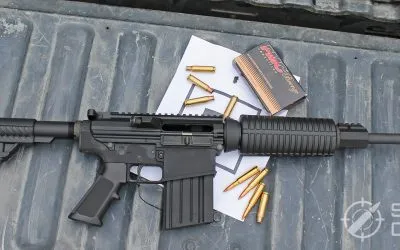
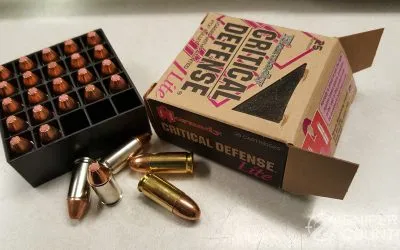
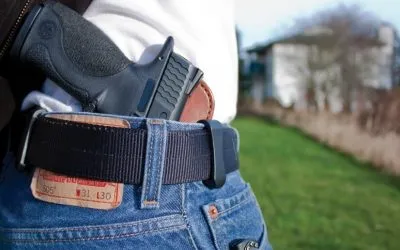
![9mm Glock Models [Ultimate Guide]](https://snipercountry.com/wp-content/uploads/2018/10/Glock-17-vs-Glock-19-vs-Glock-26-vs-Glock-41-vs-Glock-43-WM-400x250.webp)
![Handgun Caliber Chart [2025 Ultimate Guide]](https://snipercountry.com/wp-content/uploads/2018/10/Handgun-Caliber-Comparison-400x250.webp)
![Rifle Calibers [Ultimate Guide]](https://snipercountry.com/wp-content/uploads/2018/12/Header-1900-400x250.webp)





